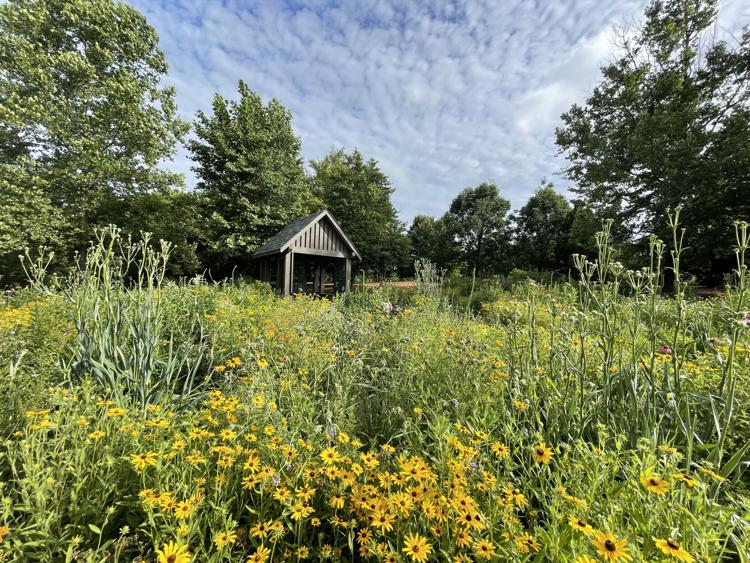The Native Pollinator Garden’s blooming display changes weekly. Pollinator-friendly black-eyed Susan, liatris, and spiky rattlesnake master are seasonal favorites.
By Claudia Watson Special to The Pilot Jun 25, 2021
The brilliant cornflower blue sky is the backdrop to the vibrant mosaic of the Native Pollinator Garden with its sweeps of summer blooms. Vivid orange milkweed mingles with yellow coreopsis, black-eyed Susan, and purple coneflower while bluestem grasses sway with the breeze.
A dragonfly catches the updraft and glides to its next landing platform, a spiky purple blazing star liatris. A green tree frog peers out from its hideaway tucked into the long fibrous leaves of a rattlesnake master just around the bend.
“The amount of color, life and movement is beautiful,” says Bonnie Winfield, of Pinehurst, observing the dance of bees, dragonflies and butterflies in the garden located in the village of Pinehurst’s Arboretum. “It’s remarkable when you stand still, watch and listen — what a show.”
Winfield and Ziggy, her pup, walk a route through the Arboretum midmorning when the warm sunshine heightens pollinator activity as they busily vie for the nectar of newly opened blossoms.
“I’ve been watching the garden develop since winter, and it’s getting more beautiful each day,” Winfield says, while identifying a pair of buckeye butterflies. “I can’t wait until the monarch butterflies are here so I can watch for the caterpillars and then the chrysalis. There’s always something new to see.”
She readily admits that the Native Pollinator Garden, in its third summer season, increases her knowledge of pollinators. It also encourages her gardening plans.
“I try to mimic what I see planted here so I can bring bees and butterflies to my home garden. I’ve planted many of these already, but next year I must have one of those big blue spiderworts, Winfield says, pointing to a garden favorite that blooms for four to six weeks.
Dr. Beth Franke Stevens, a biologist, and president of the Village Heritage Foundation, says the garden and Arboretum have enjoyed an uptick in visitors seeking a respite in nature.
On a recent morning, as the garden’’ dedicated volunteers maintained and enhanced it, several groups of visitors stopped to observe the activity.

Martha Butler and her grandchildren, Jorday (left) and Joelle (right), and their dog, Blaze, enjoyed their first visit to the garden.
Among them were Martha Butler and her grandchildren, Joelle and Jordan, and their dog Blaze.
“This is a new experience for them,” says Butler of their first visit. “They see lots of bugs on all these beautiful flowers.”
Butler smiled when Jordon accurately distinguished a round, fuzzy bumblebee from a slender honeybee.
“I had no idea how much this garden offered,” she says. “It’s a hidden gem.”
Adding to their excitement, one of the garden volunteers shouted that a yellow butterfly was following Jordan, and he turned abruptly to see it, “Wow, I’ve never had that happen! This place is pretty cool.”
“Those are the experiences we’d hoped for when we began this project,” says Dr. Lynda Acker, a biologist widely known for her understanding of the monarch butterfly’s life cycle. She and Stevens are dedicated to promoting the health of pollinators through initiatives to create habitat and support conservation.
“Each person who visits the garden takes away an experience which might inspire him or her to plant a patch of pollinator-friendly flowers at home.” says Acker. “Cumulatively, these efforts make a huge difference by providing habitat for critically diminished species.”
One of those educational initiatives is the annual Flutterby Festival, presented by the Village Heritage Foundation and the village of Pinehurst and scheduled for Saturday, Sept. 25, at the Arboretum.
The daylong event includes discussions about pollinators and the native plant species of the Sandhills. Learning activities comprise presentations on the lifecycle, migration, and plight of the monarch butterfly. The Magical Monarch Butterfly Tent offers an opportunity to interact and feed newly emerged monarch butterflies. Later, visitors can tag and release adult monarchs in time for the butterflies’ migration to Mexico.
Musicians from the Carolina Philharmonic will provide live music. In addition, food trucks will be available for the purchase of refreshments. The Flutterby Festival is family-friendly and free.
Printed with the permission of The Pilot, Southern Pines, NC 2021.
For more information about the Native Pollinator Garden, visit www.villageheritagefoundation.org.
Claudia Watson is a freelance writer.


